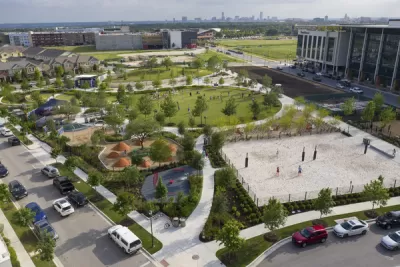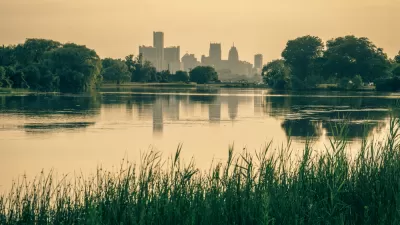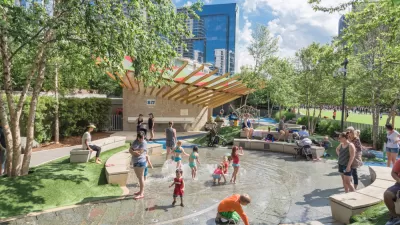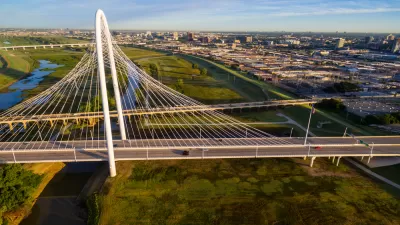Urban park planning and design needs to deliver a lot of community benefit from a small amount of space. The lessons that emerge

Our job as landscape architects and urban planners is to help cities and developers design parks that balance the best use of space with the diverse needs of the local community. Those who own a home with a backyard have significantly different needs of public outdoor spaces than those who live in an apartment. Balancing space constraints and community needs with the capital budget to build a park often requires creative problem solving. Often in urban contexts, space is at a premium, so careful consideration for how every square foot is used helps to make the most of construction and programming budgets. Similarly, construction budgets in which to build the park facilities must be spent judiciously, prioritizing what is necessary from a spatial planning perspective. This is where the community’s voice should help guide what is built within a park.
The recently opened Mary Elizabeth Branch Park (Branch Park) in the Mueller community, a mixed-income, mixed-use urban village located in Austin, Texas, is a testament to that delicate balancing act. The 3.5-acre park was designed to accommodate the various recreation needs of a multi-generational community. Opened in May 2019, Branch Park features a creative children’s playground, a dog run, a sand volleyball court, an interactive waterscape, and lawn space and shady areas for picnics.
Below are five trends landscape architects and designers are seeing across the United States that contributed to the final design of Branch Park.
Supporting Sustainable Water Usage
Parks provide more than just opportunities for recreation: they also provide opportunities to improve water quality. More parks are integrating water quality solutions into the landscape, like rain gardens that drain and clean rainwater before it moves off-site. For more efficient use of water resources, landscape architects are using reclaimed water for irrigation systems and including natural water features at parks. The rain garden in Branch Park is lushly planted with native species that can tolerate dry summer months and the wet fall and spring seasons. The rain garden treats the majority of stormwater from the park site, allowing the stormwater to slow down and percolate into the soil before it goes into the city storm sewer system. This garden is a major feature in the park, separating the interactive waterscape from the lawn and playground areas.
Accommodating All Generations
When people think of parks, they think of children as the main users, but in reality, people of all age ranges benefit from using outdoor spaces. Today’s parks need to be multi-generational and multi-functional, requiring designs and plans that create spaces that accommodate all ages. We must balance the diverse needs of empty nesters seeking outdoor space in which to relax, young adults seeking a space for an evening kickball game, teenagers who want to hang out with friends, and young kids who want to play. At Branch Park, the design team took these various experiences into account, incorporating seating options, shaded areas, viewing gardens, open spaces conducive to informal games, and a playground. The park allows all community members to enjoy the space simultaneously.


Designing for Dogs
The National Pet Owners 2017–2018 Survey by the American Pet Products Association reports 60 percent of U.S. households own a dog. When designing today’s parks, we need to keep our four-legged friends in mind. Now everyone likes dogs, but with more people living in apartments or other housing without yards, spaces for dogs are more important than ever before. In fact, the National Recreation and Park Association's 2018 Agency Performance Review found that 55 percent of park and recreation agencies now have established dog parks and those who don’t have dog parks are either in the process of building one or in the planning stages. The dog run at Branch Park allows for neighborhood dogs (and their owners) to interact with one another in a leash-free zone. Pet waste bags, disposal systems, and dog drinking fountains are supplied for convenience. Trees surrounding the dog run gives owners and their dogs a great spot in the park to enjoy throughout the year.
Integrating Interactive Waterscapes.
Interactive waterscapes, not just decorative waterscapes, are a huge trend in park design, but they also present numerous challenges. First, the waterscape needs to be well thought out when designing the park, not a feature that stands out, which is hard to do given how large they are in size. Second, there are safety concerns with standing water, so more park designers are looking for creative water features other than pools.Third, the waterscapes have to appeal to a wide age range to get maximum use. At Branch Park, water seeps, sprays, and mists out of the stonework. Interactive buttons allow people to activate certain features. In the winter, when the water is shut off, this space becomes another plaza in the park, allowing for year-round use.
Using the Sustainable SITES Framework in Planning. The requirements for SITES Certification, the LEED certification system for landscape and site design, are guiding the design of today’s parks and open spaces. Landscape architects are designing functional, beautiful spaces that benefit the environment. This impacts every step of the design and planning process, from sourcing materials and designing gardens to hiring labor and ongoing maintenance. For Branch Park, SITES Certification was an important goal for master developer Catellus, the city of Austin, and the design and construction teams, who all collaborated toward this effort with a plan to submit the plan and design of Branch Park for SITES certification in fall 2019.
A principal at Design Workshop, Claire Hempel oversees a multitude of local, regional, and international projects, including urban and regional parks, urban design, and community and environmental planning. With a background in planning and landscape architecture, Claire's professional interests include public engagement, planning on multiple scales, and empowering communities by providing them with the proper tools to achieve environmental, economic, and community goals.

Alabama: Trump Terminates Settlements for Black Communities Harmed By Raw Sewage
Trump deemed the landmark civil rights agreement “illegal DEI and environmental justice policy.”

Planetizen Federal Action Tracker
A weekly monitor of how Trump’s orders and actions are impacting planners and planning in America.

The 120 Year Old Tiny Home Villages That Sheltered San Francisco’s Earthquake Refugees
More than a century ago, San Francisco mobilized to house thousands of residents displaced by the 1906 earthquake. Could their strategy offer a model for the present?

San Francisco Opens Park on Former Great Highway
The Sunset Dunes park’s grand opening attracted both fans and detractors.

Oregon Legislature to Consider Transit Funding Laws
One proposal would increase the state’s payroll tax by .08% to fund transit agencies and expand service.

Housing Vouchers as a Key Piece of Houston’s Housing Strategy
The Houston Housing Authority supports 19,000 households through the housing voucher program.
Urban Design for Planners 1: Software Tools
This six-course series explores essential urban design concepts using open source software and equips planners with the tools they need to participate fully in the urban design process.
Planning for Universal Design
Learn the tools for implementing Universal Design in planning regulations.
Clanton & Associates, Inc.
Jessamine County Fiscal Court
Institute for Housing and Urban Development Studies (IHS)
City of Grandview
Harvard GSD Executive Education
Toledo-Lucas County Plan Commissions
Salt Lake City
NYU Wagner Graduate School of Public Service





























